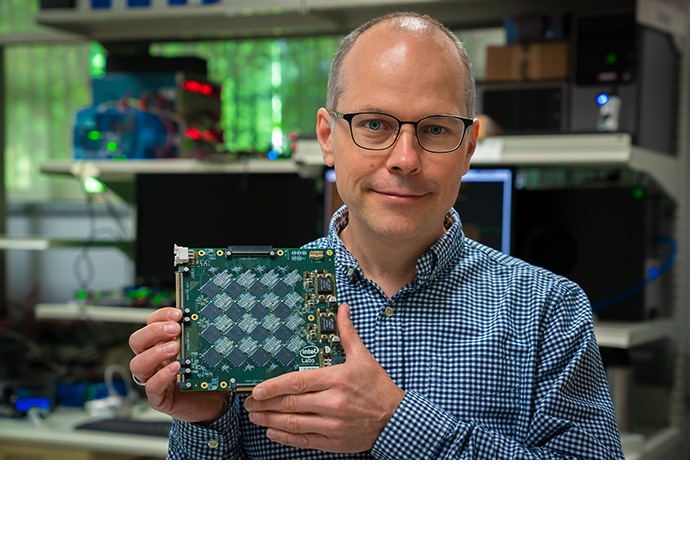IT major Intel today announced that its 8 million-neuron neuromorphic system comprising 64 Loihi research chips was now available to the broader research community.
Codenamed the “Intel Pohoiki Beach” after a black-sand beach in Hawai, Intel said in a news statement that researchers could now experiment with Intel’s brain-inspired research chip, Loihi, which applied the biological brains principles to computer architectures.
Loihi enables users to process information up to 1,000 times faster and 10,000 times more efficiently than CPUs for specialised applications like sparse coding, graph search and constraint-satisfaction problems.

Caption: Rich Uhlig, managing director of Intel Labs, holds one of Intel’s Nahuku boards, each of which contains eight to 32 Intel Loihi neuromorphic chips. Intel’s latest neuromorphic system, Pohoiki Beach, is made up of multiple Nahuku boards and contains 64 Loihi chips. Pohoiki Beach was introduced in July 2019. (Credit: Tim Herman/Intel Corporation)
The availability of Pohoiki Beach to developers is now expected to accelerate efforts for faster and greater computational scale and capacity, starting with Intel’s research partners.
Later this year, Intel announced it would introduce an even larger Loihi system named Pohoiki Springs, which will build on the Pohoiki Beach architecture to deliver an unprecedented level of performance and efficiency for scaled-up neuromorphic workloads.
Why It’s Important: With the introduction of the Intel Pohoiki Beach, researchers can now efficiently scale up novel neural-inspired algorithms — such as sparse coding, simultaneous localization and mapping (SLAM), and path planning — that can learn and adapt based on data inputs.
Why It’s Different: Continuing the gains in power and performance enabled by Moore’s Law will require more than continued process-node scaling. As new complex computing workloads become the norm, there is a growing need for specialised architectures designed for specific applications.
The Intel Pohoiki Beach neuromorphic system demonstrates the benefits of a specialized architecture for emerging applications, including some of the computational problems hardest for the Internet of Things (IoT) and autonomous devices to support. When it will be out out in the market on a commercial basis, the computing world can expect to realise orders of magnitude gains in speed and efficiency for a range of real-world applications, from autonomous vehicles to smart homes to cybersecurity.
What’s Next: In 2017, Intel introduced Loihi, its first neuromorphic research chip, taking a major step forward in the development of neuromorphic hardware. In March 2018, the company established the Intel Neuromorphic Research Community (INRC) to further the development of neuromorphic algorithms, software and applications. Through INRC, Intel provides access to its Loihi cloud systems and Kapoho Bay, a Loihi-based USB form factor system, which has invigorated research on real-world applications for neuromorphic technologies.
Intel’s engineers expect that measurements from these research systems will quantify the gains that are achievable with neuromorphic-computing methods and will clarify the application areas most suitable for the technology. This research paves the way for the eventual commercialization of neuromorphic technology.
